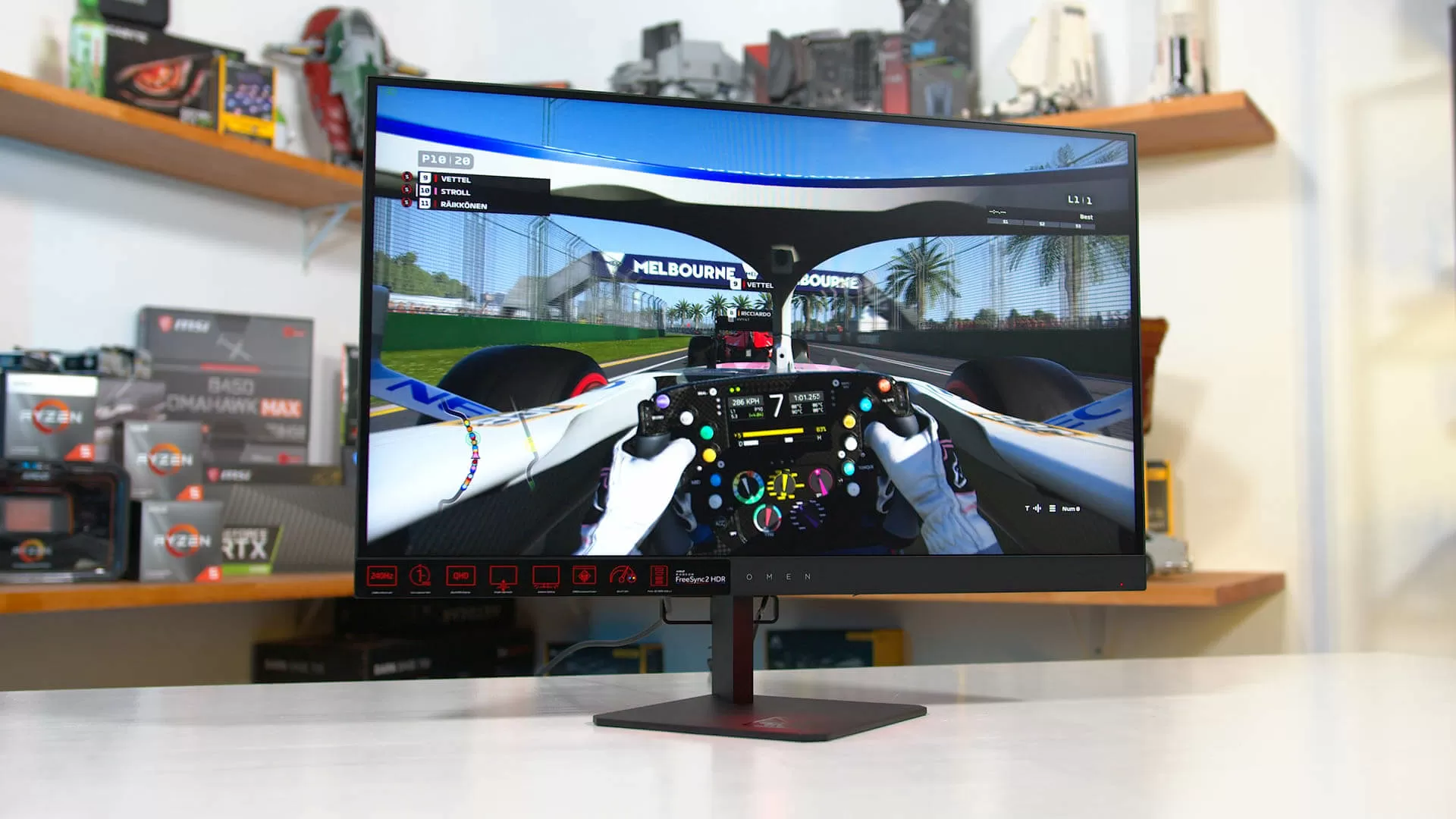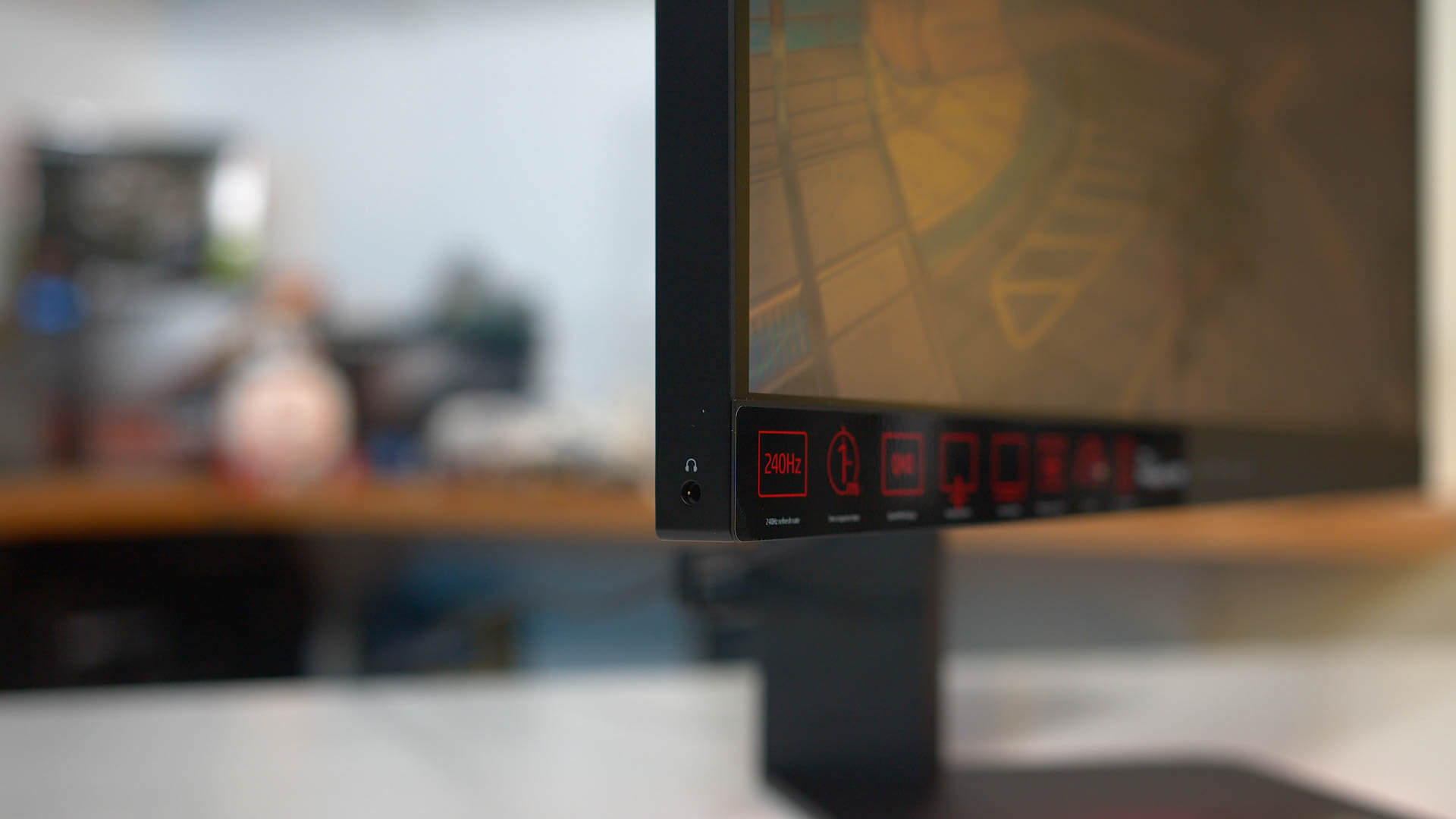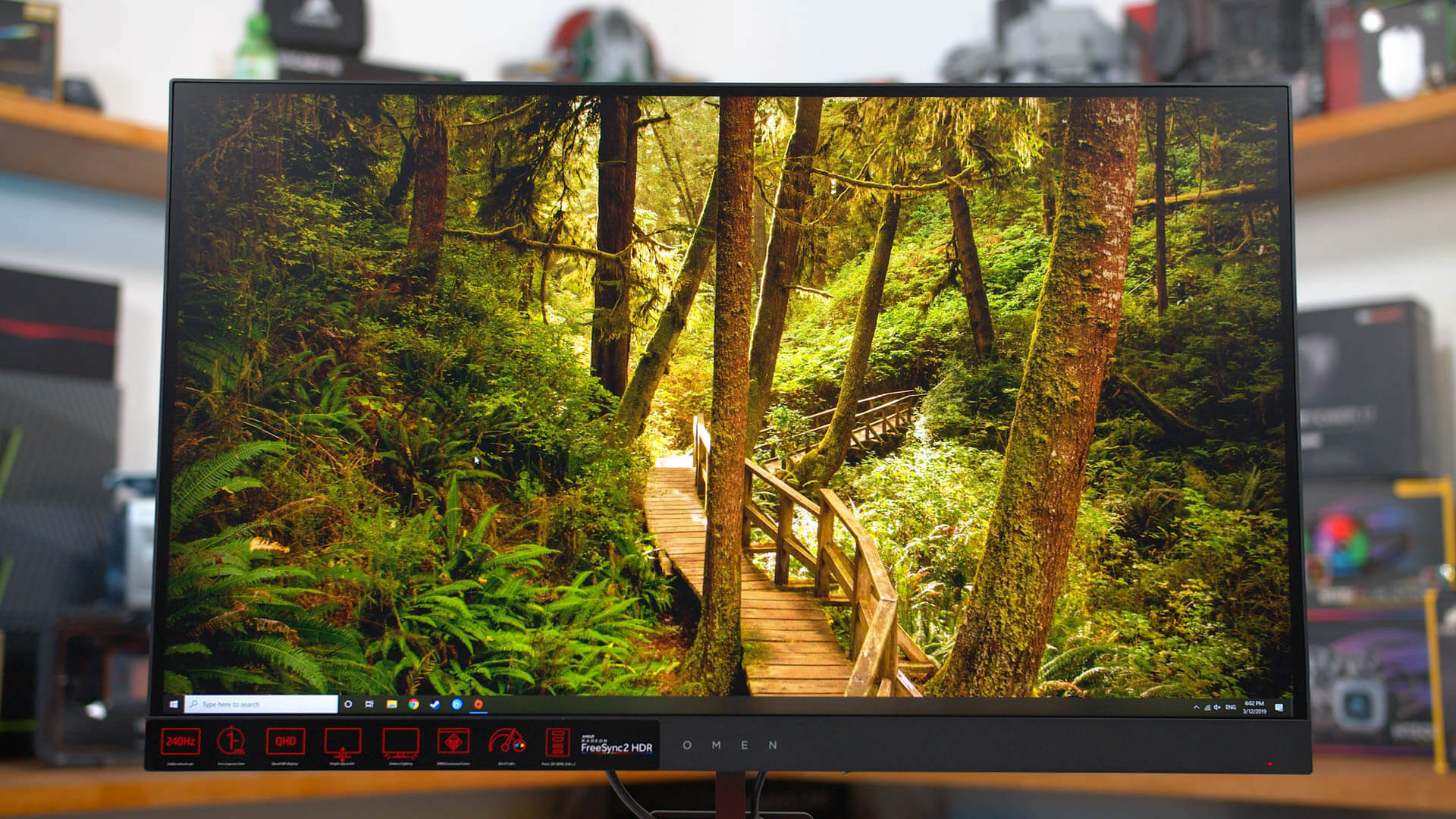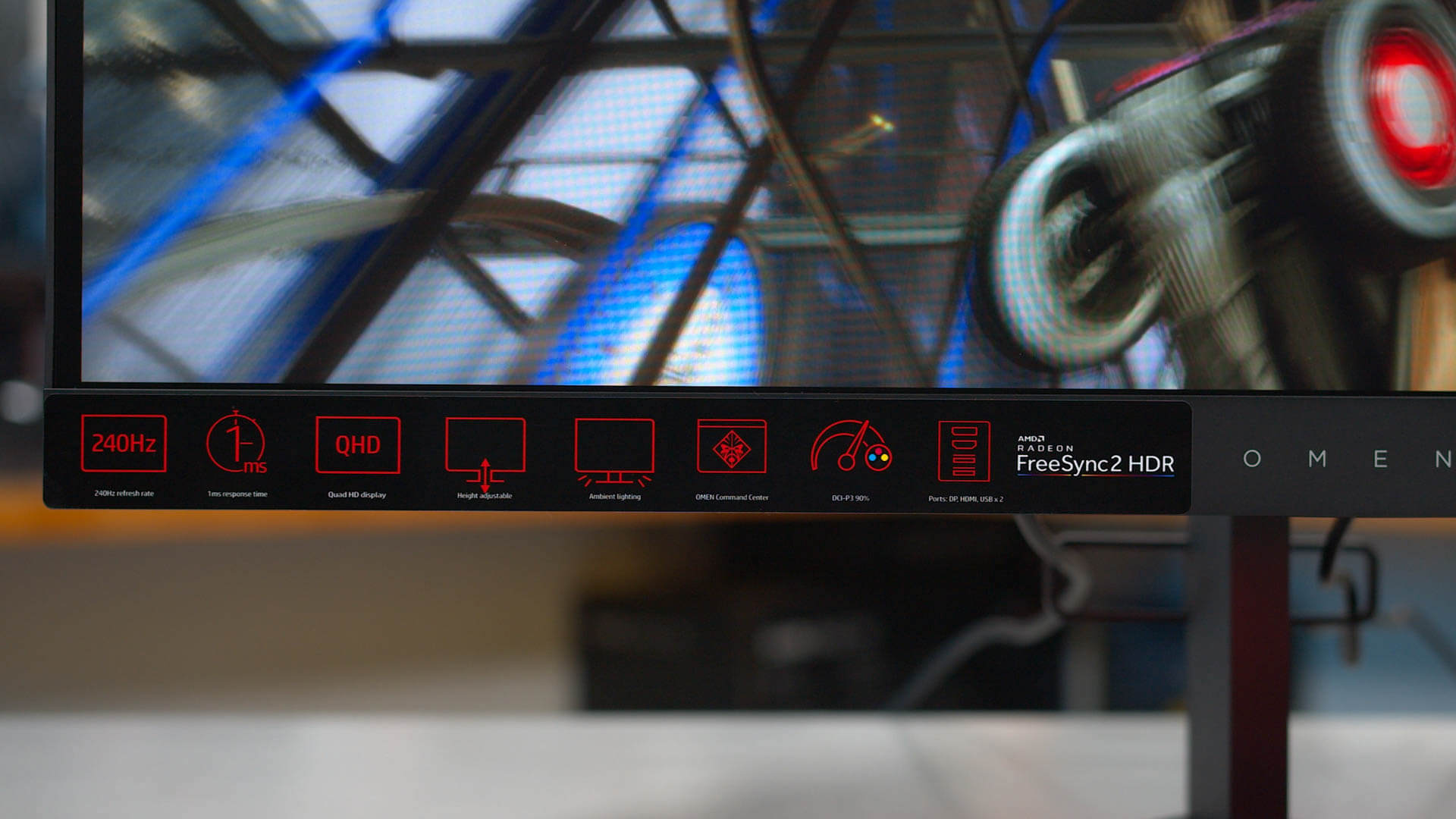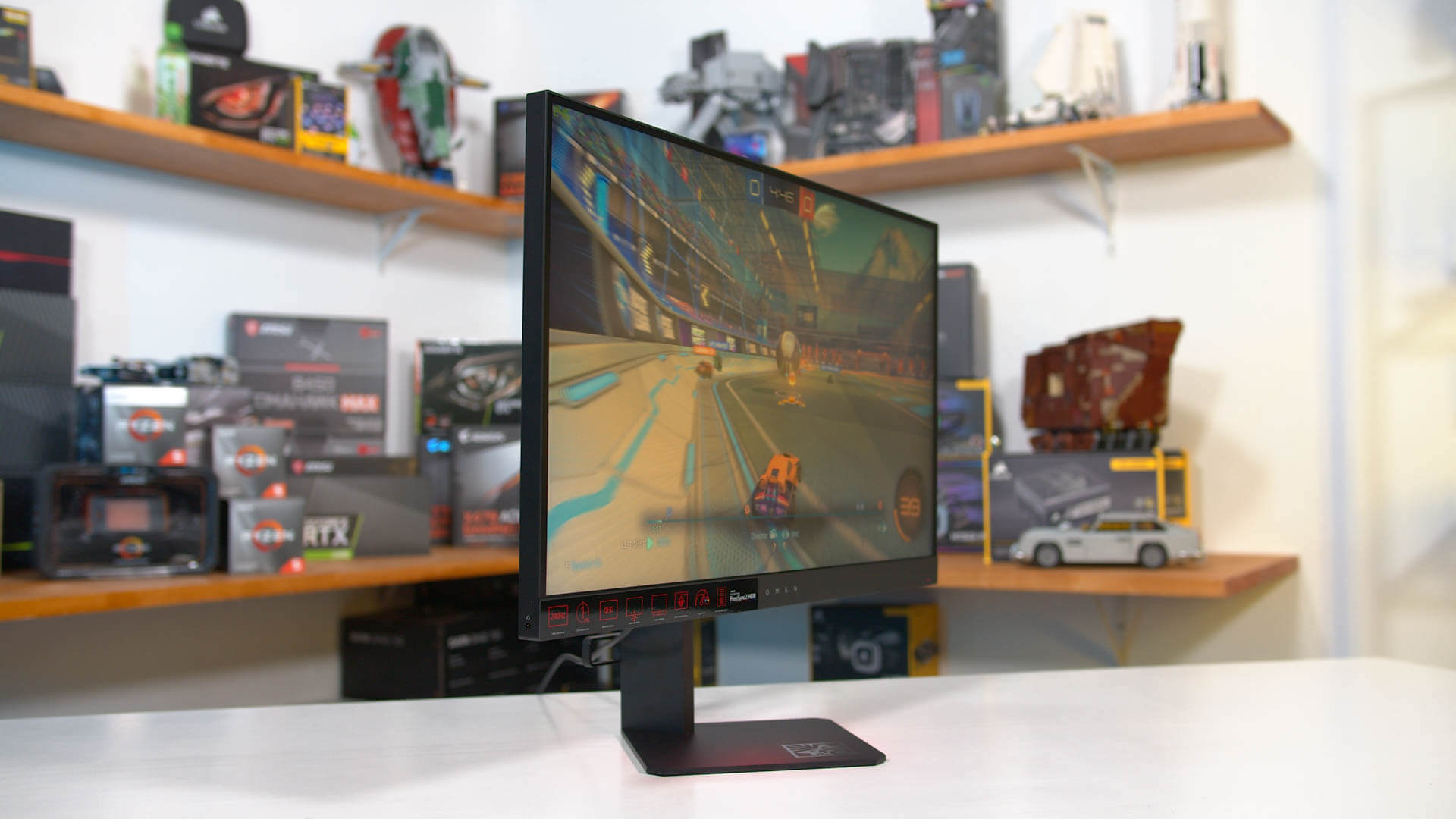This is the first HP gaming monitor we've ever reviewed and it's a special one, with an entirely new spec and milestone that recently hit the market. The HP Omen X 27 is a standard 1440p display (2560 x 1440), but it pushes the refresh rate up to 240Hz for the first time. We've had 240Hz available on 1080p monitors for some time, but 1440p hasn't been able to step up to the super high refresh podium until now with these modern panels.
It won't be a surprise to many of you that 1440p at 240Hz requires a TN panel. These days we do see some 1080p 240Hz panels using IPS and VA, but as 1080p 240Hz starts getting upgraded to better technology, TN starts to hit 240Hz at higher resolutions. This is somewhat of a comeback for TN at 1440p, given the vast majority of 1440p gaming monitors in the past few years have been released with either IPS or VA panels at up to 165Hz.
Other key specs of the HP Omen include its flat 27-inch screen size, 1ms rated response times, adaptive sync support with FreeSync 2 HDR (no VESA DisplayHDR spec) and a suggested retail price of $650. We've seen it as low as $500, but that $650 MSRP suggests this is a premium product.
The most striking thing when you take the HP Omen X 27 out of the box is its unique design. Most monitor companies stick with the basic pronged metal stand with a pillar, which is functional and looks good most of the time. But HP has gone with distinctly their own aesthetic, which includes a thin rectangular stand pillar connected to a heavy square metal base. Personally I think this looks awesome.
Everything about the build exudes premium quality. The stand is entirely metal, the seams as materials transition from one thing to another are tight and well built, plus the rear section with its triangular pattern looks fantastic even if it's entirely plastic. As far as materials go, this is definitely one of the best built monitors I've seen.
While the design is excellent, there have been some sacrifices to functionality. One is with stand adjustability: you do get height adjustment which is nice, plus the usual tilt capability, but due to the rectangular connection to the display there is no swivelling or pivoting capabilities. So you can't use the monitor in a portrait orientation.
Ports are also limited. You get a two-port USB hub and an easy to access headphone jack, but there's just one DisplayPort and one HDMI input. That's enough for a single PC and single console connection, but plenty of other monitors these days have three or four ports, which is what we'd have liked to see here, too.
The other issue comes with the on-screen controls. Not only do we have a fairly chunky bottom bezel - the side bezels are fine - but we also don't have a directional toggle or buttons along the bottom edge. Instead, the OSD buttons are actually on the rear side, and to control them you have to fumble and reach around the bottom bezel to find them. It's not a great control system and I frequently found myself pressing the wrong thing.
HP's OSD itself is good, the menu is straightforward and includes decent gamer features like cheat crosshairs, refresh rate displays, and controls for the single ambient lighting LED on the bottom edge. Perhaps one missing feature is a backlight strobing mode, though perhaps not as necessary with such a high refresh rate.
Speaking of the refresh rate, let's talk about the combination of 1440p and 240Hz. We're getting adaptive sync, so it works with AMD and Nvidia GPUs, plus low framerate compensation, as you'd expect from a modern gaming monitor. But the big jump is from a max refresh rate of 165Hz like we used to see with 1440p monitors, up to 240 Hz.
If you're thinking you can run modern AAA games at above 165 FPS in 2019, even with a GeForce RTX 2080 Ti... think again. While the 2080 Ti is undoubtedly a high-end GPU, in the most demanding titles you're looking at between 100 and 140 FPS using Ultra settings at 1440p. That allows you to max out a 1440p 144Hz display most of the time, but isn't going to make a 240 Hz display worth it. So if you're the sort of gamer that plays titles like Borderlands 3 and Star Wars Jedi Fallen Order, upgrading to 240Hz isn't going to make much sense until we have next-generation GPUs.
Where 240Hz does make sense at 1440p is with competitive games. 1080p 240Hz has been the gold standard for a while now, but at 1440p you can often still run these titles at super high frame rates while benefiting from the added spatial information from the higher resolution. I find it easier to spot enemies at 1440p versus 1080p, especially on a 27-inch monitor, and especially when we're talking about distant enemies. Similar to why competitive players often recommend low settings but ultra draw distances: seeing high quality shadows doesn't matter too much, but being able to easily spot enemies in the distance does.
If you do have a high-end rig – we're talking RTX 2080 Ti and Core i9-9900K – you can often play games like Rainbow Six Siege, Fortnite on medium settings, Overwatch, Rocket League... those sorts of titles at or above 200 FPS at 1440p. This is where a 240Hz monitor gives you improved clarity and smoothness over 144Hz, and while the difference is subtle, the more I've used 240Hz over the last few years, the more it feels like an upgrade over 144Hz in these games. For anything fast motion, more Hz is better.
Future proofing aside, having a 1440p 240Hz monitor really is only in the realm of super high-end gaming rigs. If you don't have a fast gaming CPU like Intel's 8700K or 9900K, paired with a top-end GPU like the RTX 2080 Super or preferably the RTX 2080 Ti, at least in 2019, 1440p 240Hz probably isn't for you. In a few year's time hopefully the requirements will drop down a bit like 1080p 240Hz has, but for now it's a high-end thing.
Performance
Response Times / Overdrive Modes
So how does the HP Omen X 27 perform at 1440p and 240Hz? As you probably would expect from a TN panel, it does fare pretty well in response times. There are four overdrive modes available, but the first two - Level 1 and Level 2 - aren't worth using given they don't get the best out of the panel. These modes aren't terrible given response times are in the 5ms range with minimal overshoot, but we can do better.


Level 3 is the optimal mode for this monitor. Here we are getting fast performance as you'd hope from TN. The overall grey to grey average is just 3.13ms and you can tell from the visual charts that most transitions are extremely quick at 240Hz, some as low as 1.2ms. Dark level performance is very good, so there's no smearing there either, not that this is unusual for a TN panel.

The best part comes with refresh rate compliance, 90% of transitions are within 1ms of the refresh rate window, which is a tight 4.17ms when refreshing at 240Hz. This means that smearing isn't an issue even at 240Hz, as the monitor is generally fast enough to transition its pixels before it has to refresh the screen for the next image. What we're left with is true 240 Hz performance and the extremely responsive, low blur experience that provides. Error rates are also very good, no issues to speak of, you won't see inverse ghosting at this refresh rate.
The fastest available overdrive mode, Level 4, does push the average grey to grey transition down to 1.77ms, but it does so at the expense of high levels of overshoot. 36% of transitions had overshoot above 15%, many transitions above 20% ,which does cause inverse ghost trails in fast motion. This isn't a mode I'd recommend.

Level 3 is definitely the overdrive mode to choose, and this holds up well throughout the refresh rate range. Even if you're gaming at 120Hz using adaptive sync, performance is still excellent, at a 3.16ms average response time. Overshoot does increase the slower the refresh rate is, increasing from an average error of 3.0% at 240Hz to 7.9% at 60Hz, but none of these refresh rates exhibit much inverse ghosting so that's why I'd set this monitor to Level 3 and forget. Even performance at 60Hz is great for console gaming.

How does the Omen X 27 stack up to other monitors? When looking at grey to grey average we're right in the zone for TN monitors at between 2 and 4ms. The Omen X is a step up from the Viotek GFT27DB we reviewed earlier this year, which is a 1440p 144Hz monitor, although we aren't moving the needle much in terms of delivering faster-than-usual response times. Not that this is necessary, as TN technology has been fast enough for 240Hz refresh rates at 1440p for a while now, it's just about bringing up to speed other areas of the display like the scaler.
We also see performance very close to Gigabyte's Aorus KD25F, one of the ultra-fast 0.5ms class 240Hz panels at 1080p. So at least for response times, we're equivalent to 1080p monitors at this refresh rate.

Dark level performance is obviously not an issue for TN monitors, that's only a consideration for VA. And while refresh rate compliance isn't chart topping, anything above 70 to 80% is vert good. With 91% compliance from the Omen X 27, this is more than enough for an excellent 240Hz experience and you won't get much better from other options.

The average error chart isn't the most useful in our reviews, but what we do see here is that the latest generation 1080p 240Hz panel used in the KD25F, which has 0.5ms class response times, is marginally faster than the 1440p 240Hz panel used. That's because while both options have 3ms response time averages, the KD25F does so at a lower error rate. This doesn't mean much in practice as in my opinion they offer an equivalent experience but for those that are interested in panel technology, it seems 1080p still has a slight lead.

As we mentioned earlier, inverse ghosting is a non issue with the HP Omen X 27 at its optimal overdrive mode, although the headroom is absorbed at lower refresh rates, which having increasing but still manageable overshoot.
And even at 60Hz this is still a very fast monitor, with response times still around that 3ms mark, which is impressive and makes the monitor great for adaptive sync use as we know ghosting remains largely unchanged throughout the refresh rate range.

The Omen X 27 is the fastest monitor we've tested so far, with functionally zero input lag. When that's combined with such a high refresh rate and quick transitions, we are getting 5ms of latency between the monitor receiving an input and fully displaying it on the screen. That's incredible and leads to chart topping performance by a decent margin.

All of this does come at higher than usual power consumption for a 27-inch monitor. Power usage is more than 50% higher than the Viotek GFT27DB and other TN panels, which may concern you, or it might not given we're still below 40 watts.
Color Performance
Color performance is surprisingly excellent from the HP Omen X 27, too. This is a wide gamut monitor, however even when measuring against sRGB we see good things. For starters, grayscale performance is very good out of the box, with just a deltaE average of 1.27. As usual, we're targeting below 2.0, so this is very accurate.
Default Color Performance



The CCT curve is also decent and while our unit was tinted very slightly towards the yellow end out of the box, this is a nitpick really and you won't get anything better outside of full calibration. Saturation performance is affected mostly by the unclamped gamut, but this only delivers moderately inaccurate results due to oversaturation; there are no other issues. Yes, we do see deltaE averages above 2.0 in saturation, but surprisingly in ColorChecker this is below 2.0, which is very good.
This allows it to deliver extremely strong factory calibration performance compared to other gaming monitors, which typically report in with deltaEs between 3.0 and 4.0. Were an sRGB clamp available in the settings, no doubt this would be one of the most accurate gaming monitors you can buy from the factory.
There isn't much room to tweak things further in the OSD menu, not only is the monitor quite accurate anyway out of the box, but the color controls are quite fiddly and hard to get fine control over. We'd just leave this monitor in its default configuration, which includes contrast at 80, gamma set to 2.2 and sharpness at level 4.
Calibrated Color Performance



After a full calibration we can improve things further to deliver excellent color performance. Greyscale was already a non issue although this has been tightened up slightly. It's in the saturation and ColorChecker graphs where we see the advantages of the color profile, which allows us to display both sRGB and P3 images properly in supported applications. Here with sRGB performance, we see deltaE averages around the 0.5 mark thanks to 100% sRGB coverage.

Wide gamut P3 performance isn't as strong, although it's not bad compared to monitors that have no wide gamut ability. The main problem is my unit only had native 87% coverage of P3, which drops to 85% when calibrated. So when you look at saturation sweeps for example, yes the average is decent, but top end performance is clipped as the very outer edges of P3 cannot be displayed. There are a variety of reasons why you wouldn't want a TN monitor for creative work but below 90% coverage of P3 is one item on the list.

Brightness in the SDR mode is mid tier, although anything above 300 nits is bright enough for most environments. Where this panel really suffers is with viewing angles, which are poor. There is a significant color shift at horizontal and vertical off angles, unless you view this monitor from front on at the perfect angle, you'll run into trouble with desaturation. Even with this new generation of 1440p TNs, yeah the same TN viewing angle issues are still present.

The contrast ratio is also quite weak, at just 833:1 when calibrated. Blacks just don't get very black, and while there are no major backlight bleed issues at least with my unit, if you're viewing this monitor in a dark environment you'll notice that blacks are more like a dark grey. Again, common for all but VA and OLED monitors, but it is a downside of TN technology.

As for uniformity, pretty decent, small amount of falloff along the left edge but other than that, a uniform experience through the center region. Seems HP are using a good quality panel, as you'd hope given its price tag.
The HP Omen X 27 is also an HDR capable monitor. Surprisingly it hasn't received any DisplayHDR badges, although it does come with FreeSync 2 HDR support. Let's see how it fares in the checklist.

This is a curious monitor in that it gets halfway there with each of the three main pillars of HDR. For brightness, the monitor can sustain 450 nits easily, but can't push up to 600 nits. For contrast we do get some local dimming with 16 edge lit zones, but we don't have the full array or high zone count necessary for an excellent experience. And while the monitor is wide gamut capable, around 87% P3 coverage falls just short of the 90% we ideally want to see as a minimum.
Where this leaves us in practice is an HDR experience that's better than SDR, but only slightly better, and really nowhere near the full HDR experience you'd get from a proper HDR monitor. Take brightness for example, for small details such as bright light in a dark scene, we do get up to 470 nits. But we don't get the piercing 1000+ nits of the best HDR panels.

The absolute best contrast ratio we can achieve in the HDR mode is around 6,000:1 with the Omen X, which admittedly is more than 6x higher than the panel's default SDR contrast without local dimming. But that's not that impressive against even semi-HDR monitors like the LG 32UL650 with DisplayHDR 600 certification. And in our single-frame contrast tests, again the Omen X falls behind the pack due to its low zone count.


I wouldn't completely rule out using the HDR mode as it does provide a minor advantage over SDR and the large local dimming zones aren't too noticeable during regular gaming usage. But the HDR experience isn't as good as true HDR monitors, which are much more expensive. We just don't think TN is a good technology for HDR.

But let's forget about HDR performance because we don't think you'll be buying the Omen X 27 for that feature. What you'll be interested in is the combination of a 1440p resolution and 240 Hz refresh rate. That's the star of the show and it's always exciting and interesting to test these sorts of new panels with new technologies.
Bottom Line
The HP Omen X 27 is a great gaming monitor. There are some issues brought about from using a TN panel, but that's nothing unusual for this panel type and everything else is excellent. Response times are fast enough to keep up with the 240 Hz refresh rate with a bit of room to spare, so even though we are getting an increase to resolution over older 1080p 240Hz monitors, nothing has changed as far as performance is concerned. This is a really quick monitor that delivers a top-class, highly responsive gaming experience.
HP has also delivered excellent adaptive sync support including tight response times throughout the refresh range, plus virtually zero input lag. This is one of the fastest and most responsive monitors we've ever tested, which is especially exciting given we're getting this with a higher resolution than just 1080p.
Color performance is very strong from the factory, surprisingly so for a gaming monitor that doesn't boast about factory calibration anywhere on ths spec sheet. A few minor oversaturation issues can easily be corrected with a software profile but even if you don't use a profile, this monitor has great colors.
Most of the downsides are standard TN stuff. Poor viewing angles and a weak contrast ratio are standard and the key tradeoff for elite performance. If you game in a dark room, the higher than average black levels may annoy you. And while we really love the design and build quality, there are some annoyances there, too, like a hard to use on-screen menu.
But most of those issues really aren't that significant, if you want the absolute fastest 1440p monitor on the market, there are some tradeoffs to be made. My bigger concern is more to do with the price and whether you should buy a 1440p 240Hz monitor at all.
The good news is that the HP Omen X 27 is much cheaper than their only other competitor with the same specs, the Lenovo Legion Y27gq-25. Lenovo's offering is an eye watering $1,000, although it usually sells for $900. With the Omen X 27 priced at $650, why you would spend the extra money?
However as far as 1440p displays go, $650 is still pricey. This is definitely something for ultra high-end gamers that already have a well equipped rig with a Core i9-9900K and RTX 2080 Ti because realistically, that's the sort of hardware you need to drive games at this resolution and frame rate.
Most other people could be better off with LG's 27GL850 if your hardware can't max out a 1440p 144Hz display. It's still a lightning quick monitor in terms of response times and input lag, but it has better viewing angles and a wider color gamut than the HP Omen X 27 thanks to LG's Nano IPS technology. It's also $150 cheaper comparing regular retail prices, which at $500 for the 27GL850 we think is justifiable for a high-end 1440p high refresh display.
Don't get us wrong, the HP Omen X 27 is a really great monitor that delivers excellent performance, it's just one of those more niche offerings for a super high-end audience. There is definitely a place for it in the market and we love to see new panel tech like this, but before you run out and buy one, look at the rest of your PC's hardware and decide what's most suitable for you.

